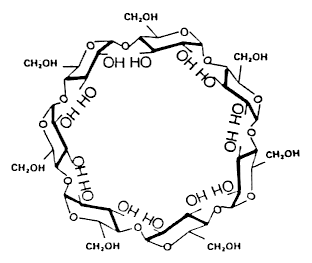 |
Inclusion complexation
Inclusion complexation is another means of achieving encapsulation. Unlike any of the processes discussed to this point, however, this technique takes place on a molecular level and utilises b-cyclodextrin as the encapsulating medium. The b-cyclodextrin molecule is a cyclic glucose polymer, consisting of seven gluco-pyranose units linked in a 1->4 position (see figure). The molecule has a donut-shaped structure with a hollow centre, which enables it to form complex with many flavours, colours, and vitamins. Due to its molecular structure, b-cyclodextrin has limited solubility, a hydrophobic centre, and a relatively hydrophilic outer surface - all of which enter into compound's formation of complex.
The b-cyclodextrin molecule forms inclusion complexes with compounds that can fit dimensionally within its cavity. These complexes are formed in a reaction that takes place only in presence of water: water molecules occupying the nonpolar cavity of the b- cyclodextrin molecule are ready substituted by less polar guest molecules. The resulting complex, which is said to be quite stable, precipitates out of solution and can to be recovered by, then dried to conventional methods. The content of core material is generally from 6 to 15 % (w/w). The odourless, crystalline complexes will tenaciously bind the guest molecules up to temperatures of 200 şC, at which point the complexes begin to decompose. In contrast, these same complexes ready dissociate to release the 'guest' in the temperature and moisture conditions of the mouth.
Inclusion complexes offer a wide range of potential applications. For example, garlic and onion oils complexed with cyclodextrin show enhanced stability to oxidation and are almost odourless, an attribute which eliminates all precautions required previously in storage and packaging. Fat soluble vitamins A, E, and K may also be stabilised to oxidation via cyclodextrin complexing. Still other potential applications include controlling flavour release, masking odours and flavours, stabilising emulsions, and enhancing solubility of hydrophobic ingredients.
Cyclodextrins are currently approved for use in foods in Japan and many Eastern European countries; however, they are not approved for use in foods in the United States or Western Europe.
 |